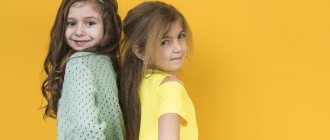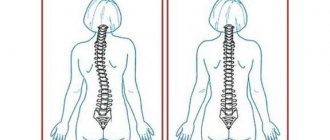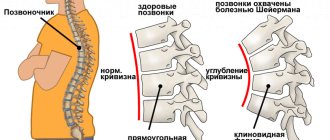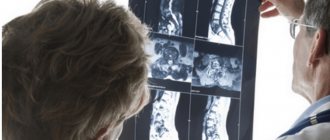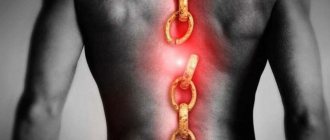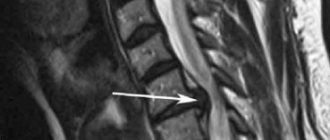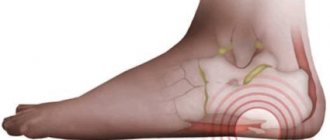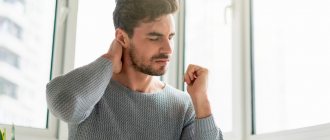Treatment of scoliosis, its identification, types and causes are often known only superficially. But when faced with it, not everyone understands what complications spinal curvature can lead to, how to treat scoliosis and prevent it from developing again in the future.
The concept of scoliosis has been known to the world since ancient times, and it received its name thanks to the Roman physician Galen at the beginning of our chronology. Of course, the problem of sitting upright, walking with a straight posture, and not taking positions that are uncomfortable or incorrect for the body is very common. This is especially true for children who at an early age expose their back to all sorts of curvatures. It is extremely difficult to keep track of them at school, but at home parents do not always pay attention to this. Moreover, they themselves can set an example while sitting hunched over the computer. However, childhood scoliosis is not a death sentence if it is not allowed to develop.
Orthopedic advice
Verbonevurologist, Candidate of Medical Sciences, Academician of the Russian Academy of Medical Sciences Mikhail Bobyr:
It is believed that people with bad backs should sleep on a hard surface, almost on a board. This is not true. It is not possible to passively cure abnormal curvature of the spine in an adult. There will only be unnecessary tension, back pain and insomnia. We need a soft surface that adapts to the shape of the human body. The best option is a block of independent springs, in which the diameter of the spring is no larger than the diameter of the vertebra (3 cm). Each vertebra will have its own support, which adapts specifically to it.
For a child
Scoliosis in a child can be completely cured, unlike in an adult. Therefore, models are selected according to a different principle.
A child is born with an unformed, not yet ossified flexible spine. Therefore, scoliosis in children under 3 years of age is a rare congenital disease. After 3 years, scoliosis can appear in a baby who is healthy at birth. Treatment is prescribed by a doctor, and the sooner it begins, the better results can be achieved. What kind of mattress is needed to cure a child? Tough is the main, but not the only condition.
Rigidity. Since scoliosis can still be corrected before the age of 18, it is worth choosing moderately or maximally rigid models in which the child’s spine will straighten under the influence of its own weight.
Fillers. Coconut coir, which should not be in an adult mattress, is a must here. Small children can sleep on a mattress made from just a block of coconut coir; for older children, you can choose models based on a spring block covered with coconut coir. To make your baby comfortable, you can choose a model with a fluffy cover or a layer of latex on top of the coconut. The main thing is that the base must be sufficiently elastic; it will serve as the child’s exoskeleton.
Design. A spring design of moderate rigidity with top layers of coconut coir and polyurethane foam is an ideal option. Spring models adapt better to the shape of the child’s body, so preference is given to them.
Example of a mattress for a child:
Mattress for teenagers DreamLine Junior Kombi S1000
Prices for Mattress for teenagers DreamLine Junior Kombi S1000 12,003 ₽ for 80×200, 19,940 ₽ for 140×200
The model has an elastic, reliable base - the S1000 block, which has 500 springs per square meter. On one side there is hard coconut, on the other there is softer artificial latex. Until the spine is completely ossified (at about 18 years old, but everything is individual), it is better for the child to sleep on coconut coir, and then you can turn the mattress over. The model can be used not only to treat scoliosis, but also to prevent its occurrence.
| Spring | 2 in 1 | Inexpensive | 18 cm |
What is spinal scoliosis?
Scoliosis is usually called a lateral curvature of the spine. However, in addition to the curvature of the spine, as the deformation progresses, it is also subject to twisting around its vertical axis.
Scoliotic curvature of the spine leads to extremely large changes in all elements of the spinal column. Depending on the degree of curvature and the time of its occurrence, scoliosis affects the growth of the vertebrae and their position. Lateral curvature is accompanied by rotation of the vertebrae and wedge-shaped deformation of the vertebral bodies and intervertebral discs. The height of the vertebral bodies is less on the concave side of scoliosis than on the convex side. Such development of wedge-shaped and rhomboid vertebrae in scoliosis is explained by a violation of their growth: overload of the vertebral bodies and discs on the concave side of the scoliosis arch leads to unilateral inhibition of height growth. Subsequently, proliferative-degenerative changes (growth of bone tissue and disruption of its structure) develop in the vertebral bodies, intervertebral discs and intervertebral joints. Along the edges of the vertebrae, beak-shaped growths (osteophytes) are formed, sometimes quite massive. In addition, intervertebral discs are deformed and intervertebral joints are destroyed. Thoracic scoliosis causes functional restructuring of the lumbar vertebrae with their deformation. The course of scoliosis becomes severe and is accompanied by the formation of gross and persistent anatomical changes in the spine and chest.
Violation of the static and dynamic functions of the spine leads to disruption of many functions of organs and systems, especially cardiovascular and respiratory.
Changing the direction of the body axis leads to the appearance of an antiscoliosis arc. Since antiscoliosis cannot fully compensate for the redistribution of body weight, muscles take over this function. Asymmetry of the muscles of the trunk, arms, legs, neck and even face gradually Therefore, collectively, all these changes are called scoliotic disease.
There are four degrees of spinal curvature, which are determined based on X-ray data. The first degree is an angle of deviation from the vertical up to 10 degrees, the second - up to 25, with the third degree changes in the spine become firmly fixed and the angle of deviation from the vertical is up to 60 degrees, and the fourth, in which there is a pronounced lateral tilt of over 60 degrees, twisting and costal deformation.
Scoliosis of the first and second degrees can be painless. But this is not always the case, especially if diseases develop that lead to compression of the spinal nerve roots. Due to asymmetry and uneven muscle load, there may be increased fatigue, weakness, aches, and then pain in the muscles not only of the back, but also in other parts of the body.
Scoliosis can be congenital, i.e. which are formed in fetal development and acquired, i.e. developed after the birth of the child.
In 1991 in Moscow, at a conference on manual therapy at MONIKI, based on numerous observations and results of treatment of scoliosis, I suggested that in the vast majority of cases, if not all, the development of acquired scoliosis is preceded by an oblique and twisted pelvis.
The pelvis is supported by the muscles of the abdomen, back, thighs and perineum. A change in muscle tension, for example, their relaxation or strengthening on one side leads to a distortion of the pelvis. For example, a child plays football and the maximum load falls on one leg. In this case, the development of muscles on the right leg (in right-handed people) will be stronger than on the non-left leg. This means that the pelvis will warp.
Notice how many people are climbing the stairs. When lifting, the main load also falls on one leg, and the other is, as it were, carried. This also causes preferential development of muscles on one side. For people involved in ballet, ballroom dancing, running, karate and other sports, the main load also falls on one leg. Boxers develop asymmetry of the trunk muscles with predominant development on the side of the striking arm, which is transmitted through the latissimus dorsi muscle to the pelvis.
The pelvis includes the sacrum, which supports all the overlying vertebrae. Once the pelvis is distorted, then along with it is the sacrum, and then the entire spine. The lumbar region experiences the greatest stress, which transmits it to all overlying departments. The greatest torsion is experienced by the thoracic region, in which the rotation of the vertebrae is influenced by the ribs connected to the vertebrae by joints and muscles. The ribs create a large torque, as a result of which scoliosis is more pronounced in the thoracic region.
The best orthopedic mattresses for adults
Mattress of Doctor Bobyr B2 S1200
Prices for the Doctor Bobyr Mattress are 37,000 ₽ for 80×200, 58,500 ₽ for 140×200
The model was developed jointly with Mikhail Bobyr, Candidate of Medical Sciences, Doctor of Osteopathy, specifically for people with back pain.
In the center lies a block of independent springs S1000, in which each spring has a diameter of 3 cm, approximately the same as that of a vertebra in the human spine.
It turns out that each vertebra has its own support, which adapts to it and provides support. One side of the spring is covered with innovative memory foam material. It is convenient to sleep on shape memory foam during an exacerbation of the disease, sharp pain in the spine - patients with scoliosis often have other back diseases, for example, spinal hernia. The firmer side with latex is comfortable to lie on after the crisis has passed.
| Spring | No glue | 2 in 1 | Up to 120 kg | 23 cm |
Mattress Promtex-Orient Soft 18 Standard 5
Prices for Mattress Promtex-Orient Soft 18 Standart 5 13,915 ₽ for 80×200, 22,495 ₽ for 140×200
A budget model that performs its functions - it supports the spine and does not compress deformed vertebrae. In the spring block, each element is in its own case, works autonomously and silently. The top layer of soft Eco Foam does not compress soft tissues and does not create stress points in the spine.
Thanks to the removable cover, the mattress is easy to care for.
| Spring | 2 in 1 | Up to 110 kg | 28 cm |
Mattress Ascona Megatrend Stark
Prices for Mattress Ascona Megatrend Stark 17,969 ₽ for 80×200, 27,250 ₽ for 140×200
A durable mattress based on a block of independent TFC springs can withstand up to 150 kg. The springs are covered with coconut coir; it evenly distributes the weight of the sleeper over the spring block. The top layer of the mattress is flexible, elastic natural latex. It adapts to the contours of the sleeper's body. Natural latex does not create stress points on the vertebrae, even in the case of significant spinal deformation. Latex is perforated, it is well ventilated, does not accumulate dust inside and creates a favorable bed microclimate.
The cover with antibacterial impregnation and micro-massage effect makes the mattress even more comfortable.
| Spring | 2 in 1 | Up to 150 kg | 24 cm |
Mattress Luntek Grand Memorix Micro
Prices for Luntek Grand Memorix Micro Mattress 23,317 ₽ for 80×200, 40,017 ₽ for 140×200
Model with two spring blocks of different heights and a high top layer of memory. On both sides the rigidity is average, but the surfaces are different.
On top, under the memory layer, there is a block of independent springs 6 cm high, and below there is a block of standard height. In both cases, the springs support the spine in the correct position, but the sleep experience is different. The memory foam layer creates no back pressure on soft tissue and creates the feeling of sleeping on a cloud.
| Spring | 2 in 1 | Up to 170 kg | 28 cm |
How long does it take to treat scoliosis?
Since the pathology has been occurring for years, it takes time to achieve a new, healthy position of the spine again. For example, in muscles, when twisting, stretching or tightening, reorientation of fibers occurs, and the synthesis of ATP, enzymes, and cellular hormones is disrupted. Changes in the functioning of internal organs occur, connections between organs and systems are disrupted. And we must also take into account that the degenerative-dystrophic changes resulting from the disease are almost irreversible. This means that it is necessary to achieve such a level of functioning of the body that these changes do not have a significant impact on the patient’s health. To restore all this, regular treatment is necessary for several years. The frequency of treatment courses is determined by the doctor.
